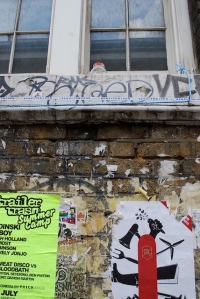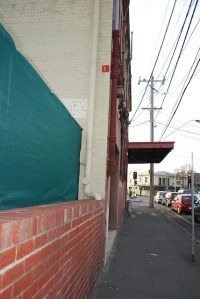Archive for the ‘stencil’ Tag
‘Be free’…
Last year, when I wasnot long returned from travelling overseas for 3 months and was taking our cat to the vet to be weighed (yes, she is on a weight reduction diet, the poor, chunky thing), I came across this artwork:
It’s a nicey composed work, a combination of stencil work for the figure and the text (which reads ‘Be Free’), with playing cards glued to the wall as though the little girl is scattering them to the winds.
I really liked its positioning and execution, and thought that it was one of the most interesting works that had appeared around Melbourne while I had been away. But I also assumed it was a single work.
Yesterday, on an evening when it was too hot to cook, we headed out to eat at a local cafe. On the way, I was delighted to discover another ‘Be Free’, freshly applied to a wall at the corner of Victoria Street and Brunswick Street:
Again, nicely positioned; again, the combination of stencil work with the playing cards to add texture and dimension.
And then this morning, in another suburb, I saw this work:
A different positioned figure this time (and an adult rather than a child), and the composition seems altered to fit the different dimensions of this space, which is at the entrance to a rather drab underpass leading away from a MacDonalds and a brothel – exactly the sort of location that to me needs an exhortation to ‘be free’.
As I came out of the underpass on the other side, I saw the local council ‘Graffiti Clean-Up’ van approaching. I hope that this beautiful work is still there tomorrow…
On being small
Reading back through some of the previous posts on this blog, I realised there is a bit of a repeated theme, in that I’ve commented favourably on the large scale of many works (for example, the works in the Leake Street Tunnel in the Cans Festivals, JR’s paste-ups in London, or Bill Viola’s images, or the works on the façade of the Tate Modern).
Since I don’t want to give the impression that an artwork has to be huge in order to impress, I thought I would devote this post to images which demonstrate that an affective charge can arise from placement and composition as much as from scale.
One of these is something that I have been thinking of as ‘art in a jar’. Have a look:

Perched on a window sill, high above ground level in Brick Lane in London, sits a little jar, with a lid on it. Inside the jar, there is a piece of paper, folded up, and on the piece of paper you can just about glimpse a drawing of a figure. I love the idea that someone not only did these little drawings but also placed them inside their own small containers and then placed the jar on a window sill, which functions as a kind of display shelf for the artwork. It’s the tiny size of the jar and its half-hidden drawing that gives the work its character, which would be lost if the jar were bigger.
I also like this stencil very much:

Taken in Richmond, Melbourne, back in 2003, it is signed by Civil and shows one of the little stick figures that have since become a signature motif, featuring in large numbers in much larger works. I like those larger images a great deal, but there’s something quite perfect about the simplicity of this: the figure, the name, and the frame.
And finally, here’s something I saw just last week. Actually, my daughter spotted it, as we were walking home from school. She suddenly stopped and pointed upwards, saying, ‘Look, mama, graffiti!’(She doesn’t make any distinction between street art and graffiti: controversial, I know, but since she is only seven, I figure she still has plenty of time to learn about the arguments as to whether graffiti is different from street art and vice versa.)
Here’s what she had spotted (and what I had missed):

And a closer view of it:

It’s a simple enough piece of work, nothing tremendously spectacular about it. But what I liked is the fact that it is placed so high on the wall (it’s a good fifteen feet up), and is thus easy to miss (as I did). It’s a great example of an artwork being there for the noticing (or not). Once noticed, its very presence brings pleasure: I now feel as though I’m party to a secret history for that little part of the street, since the presence of the artwork reveals that someone came here, probably with a ladder, and attached this image to the wall, placing it in such a way that it could be overlooked, just as it looks down at us from on high. Now I’ve seen it, it draws my gaze upwards, reminds me to be alert in the streets of the city, attentive to whatever small gifts might have been placed in public space for us to enjoy.
 Comments (4)
Comments (4)

